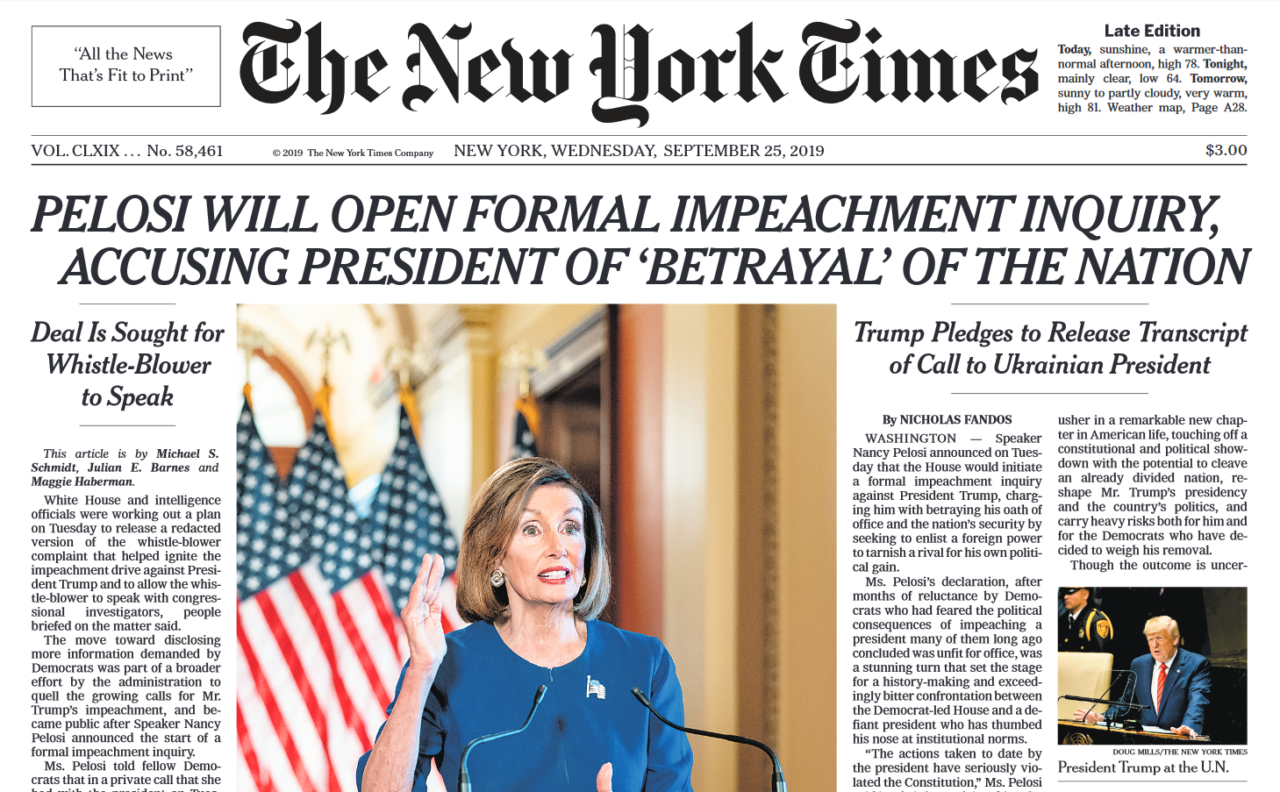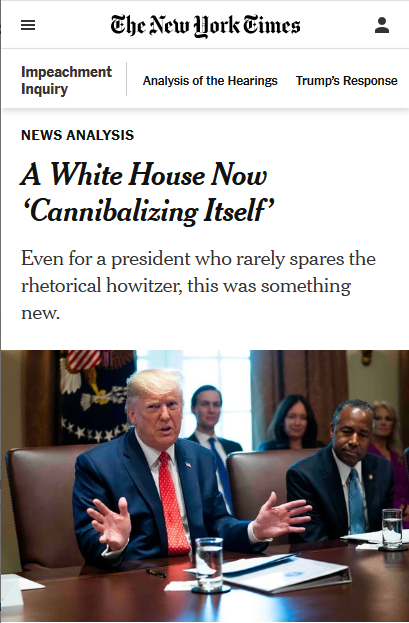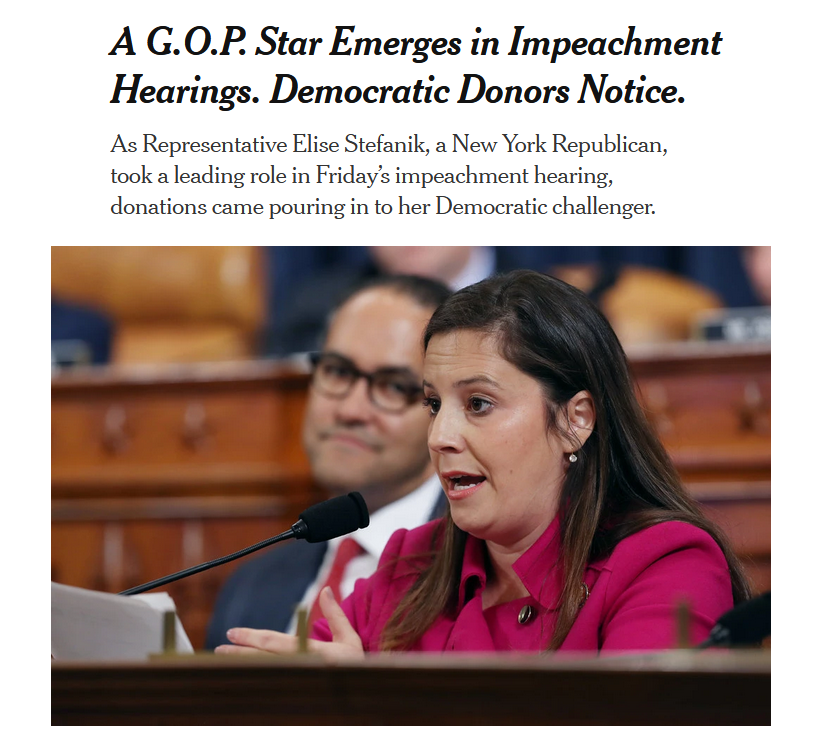
by Dorothee Benz
Congratulations, you made it through the public hearings of the impeachment inquiry, one eye on the livestream and one eye on your work email, and somehow you met your deadlines even as you followed along blow by blow. So what are you going to say about it around the Thanksgiving dinner table?
There were certainly some moments designed to stoke feelings of patriotism as we head into the heavily mythologized, uniquely American holiday this week. Alexander Vindman ( New York Times, 11/19/19): “The uniform I wear today is that of the United States Army. We do not serve any particular political party; we serve the nation.” Fiona Hill ( New York Times, 11/21/19): “I have no interest in advancing the outcome of your inquiry in any particular direction, except toward the truth.”
Perhaps you faithfully read every New York Times piece on the hearings (131 by my count as of November 22, 2019, based on their impeachment landing page). So you’re ready, maybe, to go toe-to-toe with Trump-supporting Uncle Joe about how Sondland’s story has changed and why his public testimony is the one Uncle Joe should believe.
You’re revved up by the descriptions of the “bombshell” revelations ( 11/20/19), “extraordinary” testimony ( 11/20/19) and “riveting” witnesses ( 11/21/19). Trump’s dealings with Ukraine, you are itching to pronounce no later than your first piece of pumpkin pie, are clearly, documentably a quid pro quo and an impeachable offense.
You’re right about that, but let me suggest a different approach to your anticipated intra-familial political discussion.
Burying the lead

To the New York Times (11/19/19), the interesting news is that Trump was tweeting against White House staffers—not that the Army was considering moving an officer's family onto a military base because his criticisms of the president may have put them in danger.
On November 19, in a news analysis piece titled “A White House Now ‘Cannibalizing Itself,’” the Times ( 11/19/19) went on at length (1,600 words) about the novelty of a sitting president publicly attacking members of his own staff. What the Times deemed “remarkable” was not Trump’s “attacks on his enemies real or perceived,” which “have become so routine that they now often pass unnoticed,” but rather that the “rhetorical howitzer” was now aimed at people who “still work for the very same White House that was publicly assailing them.”
Halfway through this article, there is this spartan description of threats to one such person, Col. Vindman:
The Army has been assessing potential security threats to Colonel Vindman and his brother Yevgeny, who also works at the National Security Council. There have also been discussions about moving the Vindmans and their families onto a military base for their protection.
But in contrast to the adjective-rich astonishment the Times expressed at Trump’s attacks on his own staff, this tidbit is unworthy of further comment for the paper of record. Sadly, threats of violence to anti-Trump witnesses are not new (think Christine Blasey Ford), but they are much more important to the story of the impeachment proceedings—and the survival of what is left of US democracy—than the new but unsurprising fact that Trump’s Twitter vomit has now landed on people inside the White House as well as outside.
House Intelligence Committee Chair Adam Schiff, the presiding officer at the impeachment hearings, had admonished Trump about witness intimidation four days earlier, when Trump assailed Marie Yovanovitch in a tweet during the former ambassador’s testimony. The Times article ( 11/15/19) on that incident reported:
Mr. Trump has a history of using his platform to excoriate people who are in a position to serve as witnesses to his own potential wrongdoing, using Twitter and statements at his political rallies to criticize less well-known people by name, in humiliating and sometimes threatening ways…. The tactic functions not just as an attempt to discredit his critics, but as a warning to deter others from coming forward.
This is solid and appropriate context in the story but, once again, the article stays on the surface and avoids even hinting at the consequences of this kind of political behavior, opting instead to dive into legal definitions of witness-tampering.
At the risk of stating the incredibly obvious, I’m going to say that a society in which witnesses have to fear for their safety when they expose government corruption or other wrongdoing is a society distinctly titling more towards authoritarianism than democracy. That the New York Times hasn’t raised the alarm about that is… alarming. It is more Nazi-normalizing barf journalism.
I might also suggest that phrases like “rhetorical howitzer” are better avoided under these circumstances.
Missing the point

A New York Times headline (11/18/19) combines politics as theater review with election coverage as fundraising horse race.
The larger problem with the Times’ coverage of the impeachment hearings is also exemplified in the “cannibalizing itself” article. Yes, Trump is an equal-opportunity bully and liar who is willing to attack his own staff. But the first half of that sentence is more important than the second. The Times’ emphasis in this piece reminds me of the time our son got drunk, went skateboarding, and ended up in the ER. What did he learn? we asked him afterwards.
“I shouldn’t ollie a full flight of stairs while drunk,” he replied.
The bigger and more important story is that Trump and the GOP are assaulting the legitimacy of the impeachment inquiry itself—it’s not that they are using one particular tactic or another. Everything—from refusing to turn over documents, to pressuring witnesses not to testify, to intimidating and smearing them when they do—is about a claim to unlimited executive power that is straight out of the authoritarian playbook.
The New York Times’ voluminous coverage of the hearings details many of the pieces that make up the overall strategy, but the vast majority of it boils down to the predictable formula of covering the whole process like a partisan horse race. A sampling of Times headlines:
- “An Ideal Witness for the Democrats” (11/13/19)
- “A ‘Circus’ or an ‘Education’: How Impeachment Is Playing on the Radio” (11/14/19)
- “How Swing State Voters Feel About Impeachment” (11/15/19)
- “Jordan Brings Pugnacious Style to Impeachment Defense of Trump” (11/15/19)
- “In Prime Time, Two Versions of Impeachment for a Divided Nation” (11/16/19)
- “Republicans Shift Defense of Trump While He Attacks Another Witness” (11/17/19)
- “A GOP Star Emerges in Impeachment Hearings. Democratic Donors Notice.” (11/18/19)
- “House Democrats Adopt a Sharper, Simpler Vocabulary” (11/18/19)
- “Partisan Lawyers Seize Leading Roles in Impeachment Hearings” (11/19/19)
- “A Republican Strategy Revealed” (11/19/19)
It sounds alternately like an NFL halftime report and a review of a Broadway show.
Even the five pieces described as “news analyses” that ran during the phase of the public hearings fall short of deserving that label, and none go any deeper than the rest of the coverage. “The Impeachment Witnesses Not Heard” ( 11/21/19), for instance, rehashes the relevant details of the administration’s refusal to cooperate with the investigation, and analyses the partisan considerations in GOP stonewalling and the Democrats’ decision not to go to court over it. “But it leaves some frustrated about the missing pieces,” the article says, and, folks, that’s as deep as it gets.
Less than the sum of the parts

Masha Gessen (New Yorker, 11/14/19): "To upset the equilibrium, the Democrats would have to devise a strategy that would penetrate the Republicans’ reality bubble...like an attack on all fronts."
Masha Gessen ( New Yorker, 11/14/19) provided a framing analysis in a single column that the New York Times could not manage to do in its 131 articles. The impeachment hearings, they said, consist of two simultaneous realities: one where Trump “is guilty of abusing power in many ways and on many occasions, and one such occasion is being dissected and laid out in great detail,” and the other where “Democrats are out to get Trump at any cost, have latched onto a muddled and inconsequential incident, and are laying it out in great detail.”
“These two realities do not overlap,” they note.
What euphoric Reality One acolytes see as damning testimony and obvious evidence of Trump’s guilt, Reality Two adherents dismiss out of hand as further proof that Democrats/the liberal establishment/the deep state/the media are out to get Trump. Critically, what the Reality One camp doesn’t understand is that for the Reality Two camp the incoherence of Republican attacks on the evidence doesn’t matter. Gessen gets to the heart of it:
Republicans are not actually defending the president against accusations of abuse of power; instead, they are mounting an offense against the Democrats, whose very enterprise they consider illegitimate.
Gessen’s point is that the Republicans are playing a whole different game than the Democrats, and the Democrats don’t realize it and will lose as a result:
The impeachment hearings ought to lay down a record of abuses that will make future historians blush, rather than a protocol of the time that the Democrats tried to get Trump on the one obscure smoking gun they had—and failed.
Agreed. 🤦
But that the Democrats have, true to form, opted to make the whole less than the sum of its parts, is no excuse for the media to do the same.
Why exactly the New York Times is studiously keeping its impeachment coverage so superficial I don’t know. My hunch is that it has to do with the Times’ longstanding affinity for legitimizing power and, as I’ve said elsewhere, the belief that the stability of US institutions is more important than their integrity. Naming and scrutinizing the extent of the assault on democratic norms revealed in the impeachment proceedings would lay bare the fragility of those institutions. But honestly, I don’t know, and that is a speculation.
But that this approach to covering the Trump administration is deliberate is quite clear. On Sunday, former Times copy editor Carlos Cunha ( Salon, 11/24/19) exposed what he called the “project of Trump-dignification” at the paper (and I call, following Bess Kalb, Nazi-normalizing barf journalism), detailing not only how he was fired for a single edit seen as unfair to the Trumpists, but also how the Times’ upper brass has sought to placate Trump (including the refusal to call him a racist).
The myth of objective journalism
While I can’t answer the big question of why the Times’ coverage is content to stay lost in the trees and avoid looking at the forest, I want to highlight two factors that clearly contribute to the phenomenon.

In the New York Times (11/15/19), Trump attacking a witness testifying against him isn't witness intimidation; it just "raises charges of witness intimidation."
The first is the use of false equivalencies in the name of “not taking sides” (a well-documented problem that FAIR readers are familiar with). This takes the form of he-said-she-said reporting, for instance in the pairing ( 11/15/19) of Adam Schiff’s statement that Trump’s tweet about Yovanovitch was witness intimidation with the White House’s statement that it was not; and also the presentation of both true and false statements as ‘so-and-so claims…’ “Democrats argued that Sondland’s testimony bolstered their case for impeaching Trump” ( 11/20/19), for example, could more accurately be rendered, “Sondland’s testimony bolstered the Democratic case for impeaching Trump.”
The larger problem with this approach to reporting is that it severely inhibits the ability to offer any analysis of political processes, a fact that itself reinforces the status quo and thus belies the idea that this approach is somehow objective.
The second factor clearly contributing to the Times’ narrow lens on the impeachment process is that your Uncle Joe is in fact right: The “liberal media” do hate Trump. (You say liberal, I say neoliberal… basically corporate media; not all of it, but most of it.)
Mainstream media disdain for Trump is obvious in thousands of details every day, but precisely because of the myth of objective journalism, reporters’ and editors’ views of how Trump is a bad president or a terrible human being have no legitimized expression. Rather than being clearly stated, where they can be debated, they are passive aggressively inserted in nuggets like the Times’ comment ( 11/20/19) on the note Trump read to reporters—“scrawled out in large block letters.”
I believe it is that same anti-Trump perspective that has led the New York Times to follow the Beltway impeachment crowd over the cliff in their pursuit of that “one obscure smoking gun,” as Gessen put it. Rather than explore the full extent of the Trumpist lurch towards authoritarianism, much of which is palpable and documentable but not necessarily “provable” in the way the Ukrainian extortion scheme is, they’ve gone all in on the obsession with the smoking gun.
It’s a bitter irony that the Times’ bias against Trump has contributed to the downplaying of the danger he poses to the US.
But it might give you and Uncle Joe something to agree on, from which, who knows, maybe you’ll convince him to start watching Democracy Now! with you.
You can send a message to the New York Times at letters@nytimes.com (Twitter:@NYTimes). Please remember that respectful communication is the most effective.
|
No comments:
Post a Comment